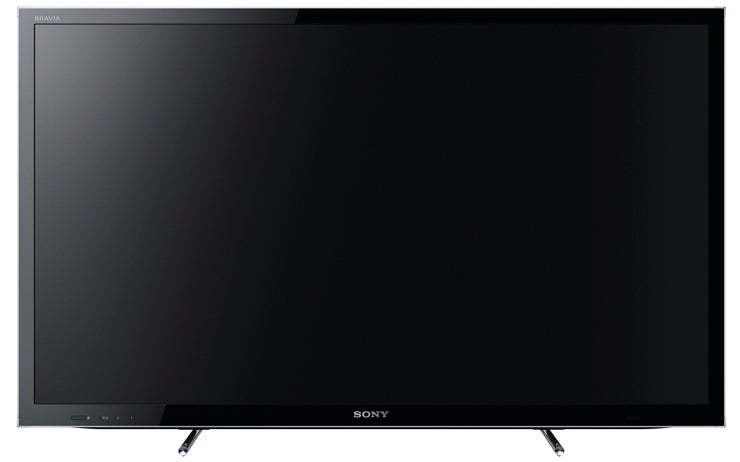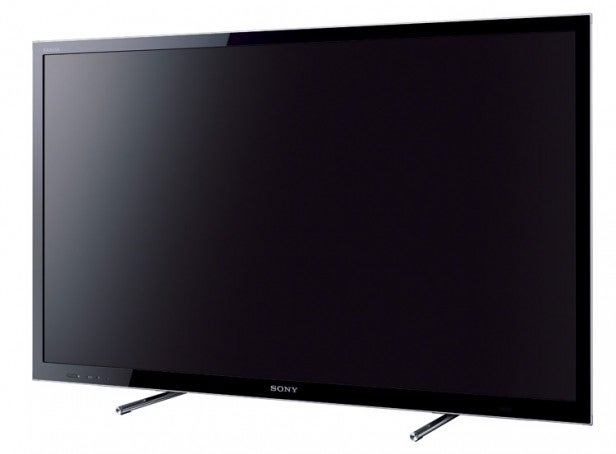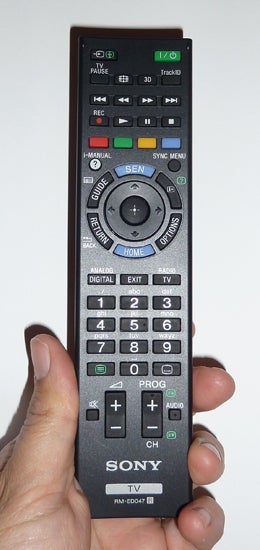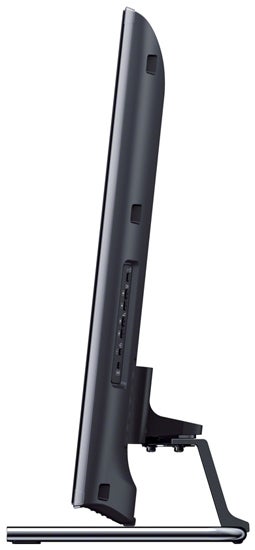Sony KDL-32HX753 Review
Sony KDL-32HX753
Can Sony's new HX753 series continue the run of form kicked off by the outstanding HX853s?

Verdict
Pros
- Crosstalk-light 3D pictures
- Excellent online features
- Can work well in a dark environment
Cons
- Black levels not great with most picture settings
- Pictures lack dynamism
- Input lag
Key Specifications
- Review Price: £619.00
- 32in LCD with edge LED lighting
- Active 3D playback
- Sony Entertainment Network online features
- '400Hz' system
- DLNA and USB multimedia playback
Sony has got off to a stonking start this year with its outstanding HX853 series – TVs which have, in some ways, redefined our idea of what’s possible from edge LED technology.
However, with times still looking frighteningly hard, there will doubtless be many, many people out there looking to save a few bob by reluctantly giving up on the HX853s in favour of Sony’s new step-down range, the HX753s.
The 55in, 46in and 40in options in this range go for around £300 less than their equivalent HX853 models, plus you can get an additional 32in model – and it’s actually this £700 Sony KDL-32HX753 that we’re looking at here as our first experience of the new HX7 series.
The Sony KDL-32HX753 continues the tweaked Monolithic design theme introduced by the HX853, with a reasonably slender black screen frame offset by a pleasant silver outer trim. However, the build quality isn’t nearly as opulent as that of the HX8 series, if that bothers you.
Connections
Connections are pretty decent for a mid-range TV, with highlights comprising four HDMIs (all built to the v1.4 standard to support the set’s built-in active 3D playback capabilities), two USBs to support playback of a fair-to-middling array of file formats from USB storage devices, and both LAN and built-in Wi-Fi options for streaming content from networked PCs or Sony’s latest online service.
The networked computer support actually extends to Macs as well as PCs if you avail yourself of Sony’s free Homestream software, which is nice. As for the set’s online services, they’re now built around Sony’s new SEN platform.
SEN brings it all together
The reason for switching from the previous Bravia Internet Video name is essentially that Sony has finally managed to aggregate the previously frustratingly disparate parts of its online content services together into a more homogenous, multi-platform whole – an improvement that follows through into the much improved online interface Sony has put together for its 2012 ‘Smart’ TVs.
After accessing the SEN via a dedicated and highlighted button on the Sony KDL-32HX753’s remote, you’re greeted – after a slightly annoying delay – by a very pleasant onscreen menu system. This comprises a smallish window on the left showing the TV programme you were watching when you hit the SEN button plus, if you wish, your Twitter feed ‘ticker taping’ underneath it. To the right of this there’s an Apps area containing icon-based leap offs to essentially all the current SEN content bar Sony’s own Video Unlimited and Music unlimited services. These latter two services get their own Video and Music sections to the right of the Apps one. 
We guess some people might not like Sony promoting its own services so overtly. But Sony has provided a ‘Favourites’ section on its SEN home screen into which you can move stuff like Netflix and LoveFilm (initially tucked down inside the apps list) if you want to be able to access them more quickly. Also, there is a practical benefit to Sony’s approach, since it allows jump-off icons taking you straight into video or music streams to appear on the SEN home page.
A final point to add here is that after a predictably slightly ‘tricky’ start, Sony’s Video and especially Music Unlimited services have really started to become quite compelling propositions.
The differences start here
So far we haven’t found any huge differences between the KDL-32HX753 and its illustrious HX853 siblings. But this changes as we get to grips with some of the 32in set’s key specifications. Particularly important is the fact that while the 32HX753 joins the HX853 models in employing edge LED lighting, it doesn’t copy the HX853 in sporting local dimming.
In other words, it can’t dim different areas of the edge LED array individually to boost contrast and black level response. Given how brilliantly local dimming was used on the HX853, we can’t help but worry about how drastic an effect removing this feature might have on the Sony KDL-32HX753 . Though of course, we guess something had to give to make the HX753 models much cheaper than the HX853s…
Local dimming isn’t the only significant step-down in spec, though. For the Sony KDL-32HX753 also only gets Sony’s X-Reality processing rather than the souped-up Pro version that was such a hit on the HX853s. This should find the 32HX753 less clever when it comes to upscaling low-quality source content – especially stuff streamed from t’internet – and also means it won’t deliver the startling 3D sharpness boost available on the HX853s.
Motion demotion
And still there’s more. For while the HX853s get Sony’s MotionFlow XR 800 (800Hz-alike) system, the 32HX753 gets MotionFlow XR 400. You still get a wide variety of motion settings, though, including the new but ultimately flawed Impulse mode, which reduces blur but also introduces a distracting flickering effect. The Clear motion option was the only one we got much joy out of, really.
Happily, the 32HX753 also retains a reasonable set of picture set up aids, including a degree of colour/white balance management and some gamma controls. It also lets you tweak the strength of almost all aspects of its video processing, which is, of course, likely to prove invaluable to serious users.
The problem with making a flagship TV range as hugely impressive as the HX853s is that you potentially set yourself up for a fall with your more affordable models. And at first glance the 32HX753 seems very much a victim of this situation, with its pictures looking startlingly short of punch and contrast versus its higher-end sibling. Thankfully the 32HX753 does gradually reveal a few charms – though even by the end of our testing we still couldn’t help feeling just a bit underwhelmed.
Black level problems
The main problem is that the 32HX753 struggles to produce a truly convincing black colour. Out of the box, dark scenes thus look a little greyed over and, as a result, rather short of shadow detail at times. Colours during dark scenes can look slightly unnatural, too.
The good news is that you can actually get the 32HX753 to produce a really pretty good black level performance if you’re very careful with how you set it up. This means at the very least using the Cinema 2 preset, nudging the backlight output down an extra step or two, and then dimming the light levels in your room as much as possible to compensate for the brightness you’ve had to remove from the images.
The settings that give you a good picture on the 32HX753 really don’t work well in a bright room at all. Yet as soon as you attempt to make pictures brighter, the set’s black level response goes downhill alarmingly fast. 
Were the 32HX753 a large TV likely to find a place in the living room of a serious AV enthusiast, we could perhaps – though only perhaps – see past the TV’s limited set of ‘ideal settings’. But as a 32in set it’s as likely to end up as a second TV in a kitchen or conservatory, where its problems delivering a very satisfying picture in bright conditions will become pretty acute.
It’s actually not just the 32HX753’s black levels that struggle if you try to make its pictures look more dynamic. In fact, the set doesn’t really do dynamic, no matter what you try; the screen just doesn’t have in its arsenal the sort of bold brightness levels and vivid colour saturations you usually expect with edge LED TVs.
Catering for the enthusiast?
Again this is not necessarily a problem to relatively serious viewers. The way the set’s pictures suddenly make sense when calibrated for dark room viewing suggests that Sony has deliberately tuned the 32HX753 to deliver ‘accurate’ pictures in line with industry standards rather than going for showboating visceral thrills.
However, we’d argue that there are other sets out there with panels flexible enough to deliver vibrancy, punch and rich black levels when required as well as more gentle, subtle images for low-light viewing. It’s the 32HX753’s single mindedness that ultimately grates, especially given the aforementioned burden on 32in TVs to be potentially more flexible than larger screens.
Looking past the contrast issues and/or using the Sony 32HX753 with its optimum settings in play, you really can appreciate its image strengths. There’s a reasonable if not exactly forensic amount of detail to be seen with good HD feeds, for instance, especially as the set’s relatively subdued approach to colours lets you appreciate lots of subtle nuances that can ‘flare out’ with more punchy TVs.
Motion handling
Motion is handled well too. There’s a touch more judder and resolution loss over moving objects than you get with the exemplary HX853 models, but it’s not a big deal and is actually good by the standards of the 32HX753’s mid-range level.
Once you’ve secured a pair of Sony’s 3D glasses (none, sadly, are included as standard) the 32HX753 proves a surprising hit with 3D too – at least to the extent that it suffers vastly less from crosstalk than some of Sony’s mid-level 2011 TVs. In fact, it felt to us as if the 32HX753 suffered less with crosstalk’s ghosting noise than the HX853s.
Inevitably the set’s subdued nature means that 3D pictures don’t enjoy the same sort of vibrancy and brightness as those of the HX853s, and they also look a bit softer, as there’s no X-Reality Pro available to give them a sharpness boost. But they still look HD, despite the relatively small dimensions of the screen.
Size matters
These dimensions again do the Sony 32HX753 no favours, though. For so far as we’re concerned 3D only really makes sense on pretty big TVs, where the image can dominate your field of vision. On 32in TVs, unless you are sat very close, 3D tends to feel a bit odd – like you’re watching a separate 3D hole ripped within the already 3D view you have of your living room.
The TV’s 3D capabilities are probably best suited to gamers, who might well have a set like the 32HX753 set up in a bedroom or small study. But with this in mind it’s a pity that, rather inexplicably, the 32HX753 recorded an input lag figure of around 80ms during our tests. This is roughly double the input lag we’d usually expect to find on a Sony TV, and certainly has the potential to diminish your gaming performance.
Wrapping things up with the 32HX753’s audio, we find its speakers serving up a fair to middling performance. The mid-range is more open and less prone to distortion than that of many 32in TVs, but at the same time the set doesn’t escape the all-too-common complaint of lacking bass, which leaves action movie soundtracks a bit thin and some male voices sounding slightly emasculated.
Verdict
After the bounty of pleasures afforded by Sony’s HX853 series, the 32HX753 proves surprisingly difficult to really like. Get it set up absolutely right and it can produce an impressively balanced and laudably subtle picture performance. But this ‘sweet spot’ is too narrow for comfort, and too restrictive on the sort of room environments the TV can really work in – hardly ideal given the increasingly utilitarian way in which 32in TVs tend to be treated these days.
It’s possible – though far from certain – that larger sizes of the HX753 series might be able to counter some of our arguments against the 32HX753. But so far as this 32in model is concerned, it represents a bigger step down from Sony’s flagship HX853s than we’d – perhaps unreasonably – been hoping for.
How we test televisions
We test every TV we review thoroughly over an extended period of time. We use industry standard tests to compare features properly. We’ll always tell you what we find. We never, ever, accept money to review a product.
Trusted Score
Score in detail
-
Features 9
-
3D Quality 8
-
Value 7
-
Design 8
-
2D Quality 7
-
Sound Quality 7
Features
| Size (Inch) | 32in |
| Display Type | LED |
| Max. Resolution | 1920 x 1080 |
| Full HD 1080p | Yes |
| Digital Tuner | Yes |
| Freeview HD | Yes |
| Freesat HD | No |
| 3D Ready | Yes |
| Contrast Ratio | 1,000,000:1 claimed |
| Refresh Rate (Hertz) | '400'Hz |
Connectivity
| HDMI | 4 (v1.4) |
| Component | 1 |
| Composite | 1 |
| Scart | 1 (RGB) |
| Digital Audio Out | 1 (optical) |
| Headphone | 1 |
| Charging/Computer Connection | 2 |
| Ethernet | Yes |
| WiFi | Yes (built-in) |
Physical Specifications
| Height (Millimeter) | 473mm |
| Width (Millimeter) | 756mm |
| Depth (Millimeter) | 59mm |
| Weight (Gram) | 8g |

